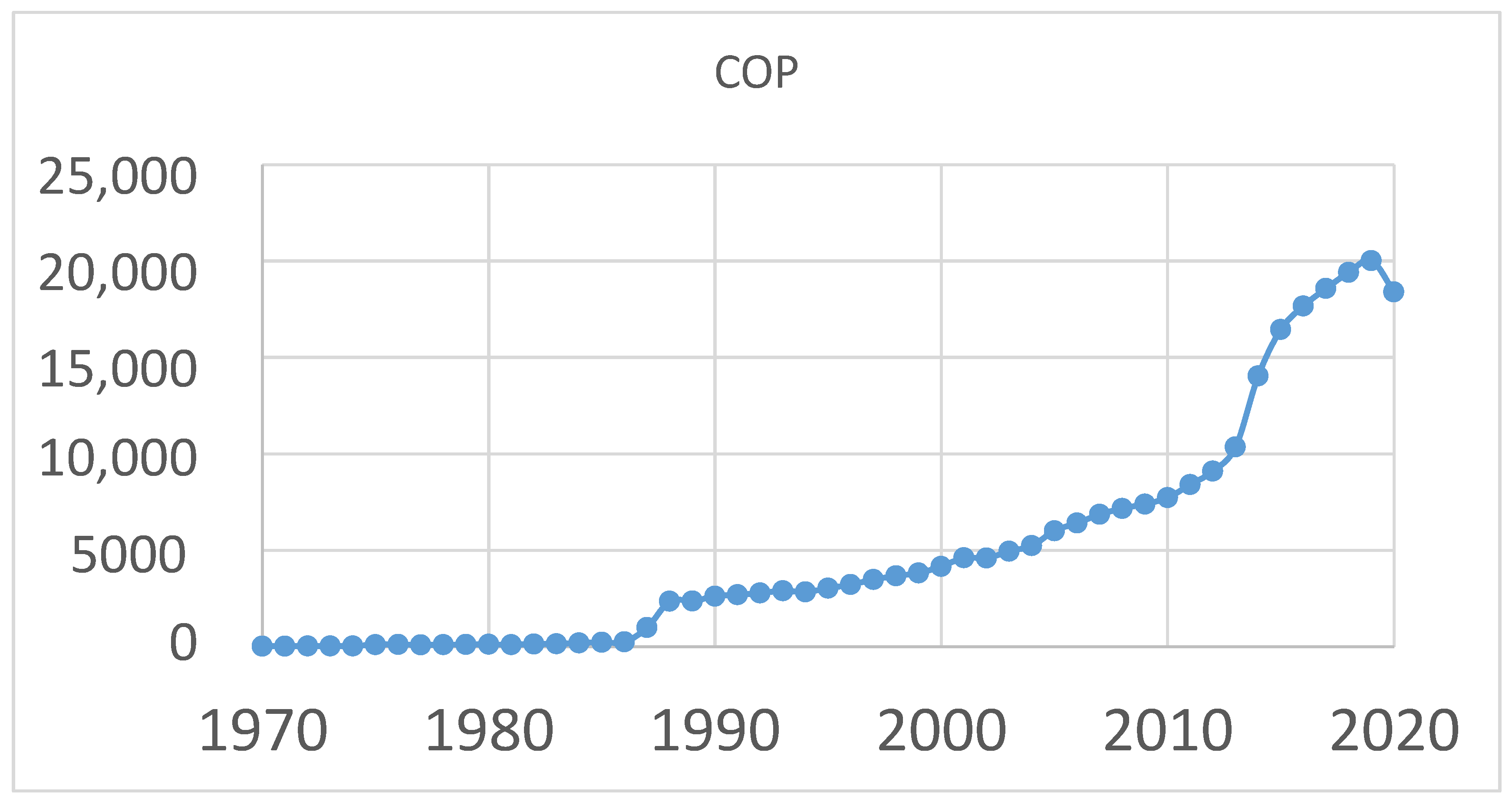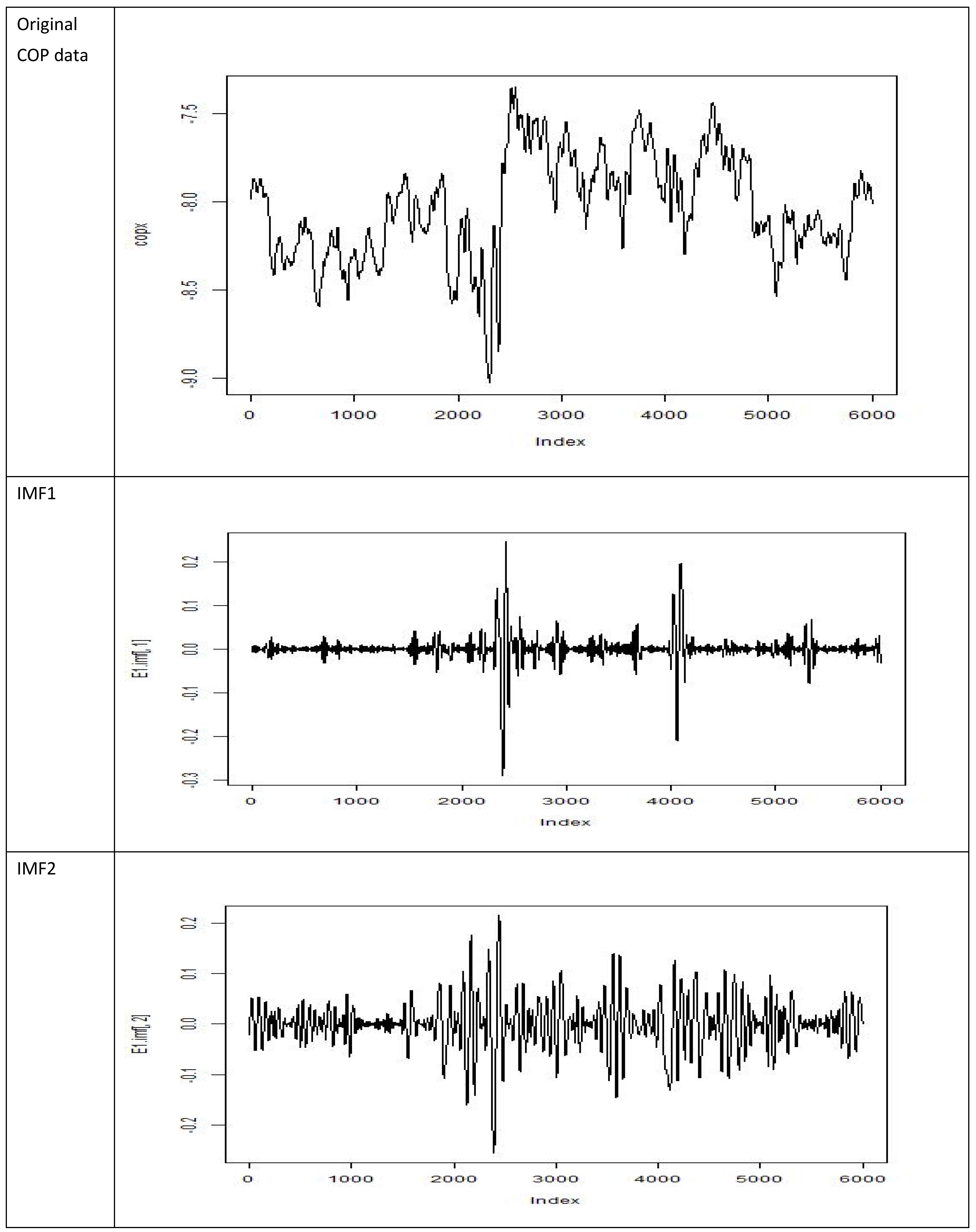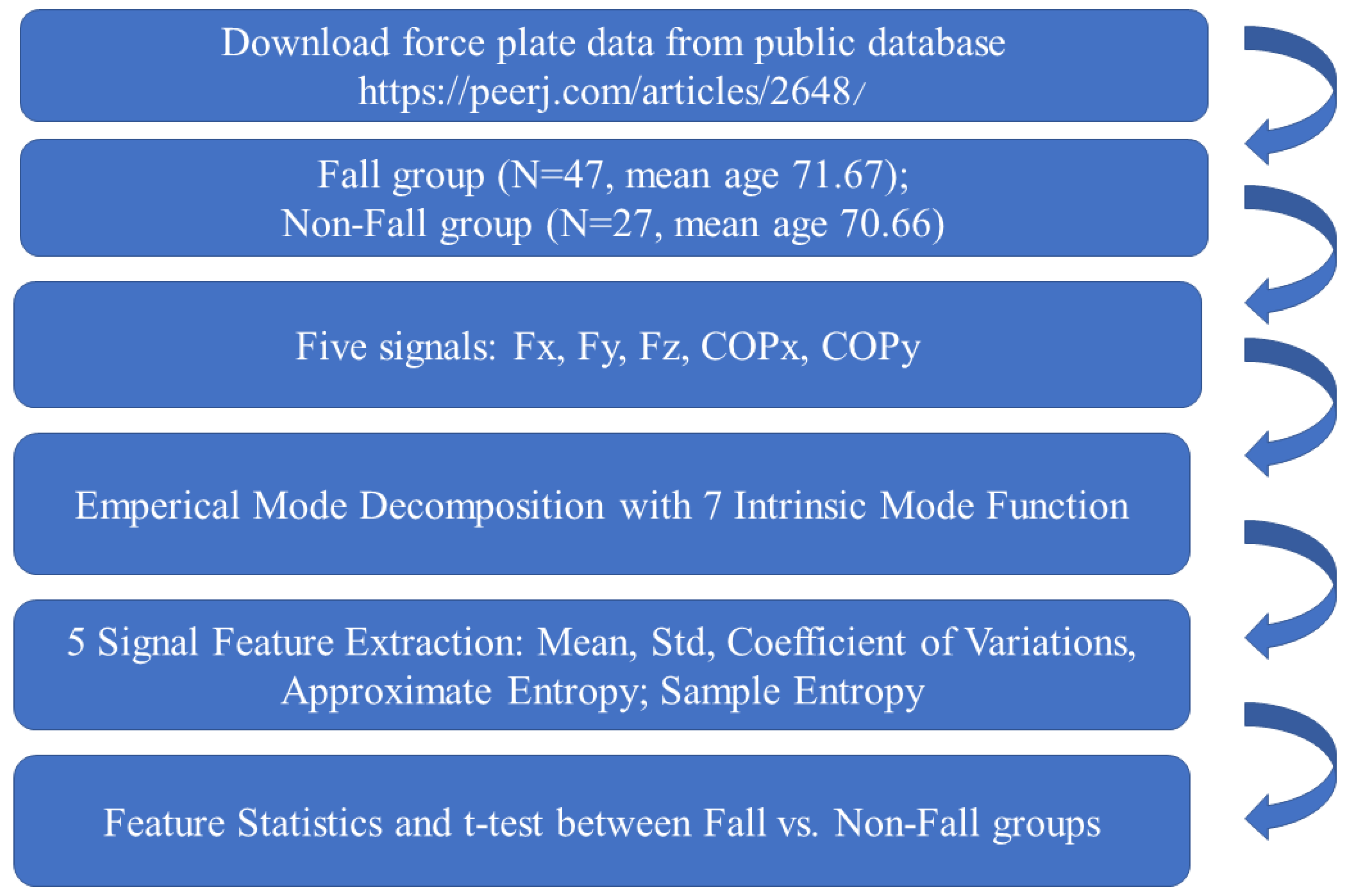Empirical Mode Decomposition-Derived Entropy Features Are Beneficial to Distinguish Elderly People with a Falling History on a Force Plate Signal
Abstract
1. Introduction
2. Materials and Methods
2.1. Subject and Data Information
2.2. EMD
2.3. COP Feature Extraction and Statistics
3. Results
4. Discussion
5. Conclusions
Author Contributions
Funding
Institutional Review Board Statement
Informed Consent Statement
Data Availability Statement
Acknowledgments
Conflicts of Interest
Appendix A
Appendix B
References
- World Health Organization. Falls. Available online: https://www.who.int/news-room/fact-sheets/detail/falls (accessed on 6 March 2020).
- Juarez, J.M.; Ochotorena, J.M.; Campos, M.; Combi, C. Spatiotemporal data visualisation for homecare monitoring of elderly people. Artif. Intell. Med. 2015, 65, 97–111. [Google Scholar] [CrossRef]
- Bian, Z.-P.; Hou, J.; Chau, L.-P.; Magnenat-Thalmann, N. Fall detection based on body part tracking using a depth camera. IEEE J. Biomed. Health Inform. 2014, 19, 430–439. [Google Scholar] [CrossRef]
- Rivolta, M.W.; Aktaruzzaman, M.; Rizzo, G.; Lafortuna, C.L.; Ferrarin, M.; Bovi, G.; Bonardi, D.R.; Caspani, A.; Sassi, R. Evaluation of the Tinetti score and fall risk assessment via accelerometry-based movement analysis. Artif. Intell. Med. 2019, 95, 38–47. [Google Scholar] [CrossRef]
- Zhu, Y.; Weiyi, X.; Luo, G.; Wang, H.; Yang, J.; Lu, W. Random Forest enhancement using improved Artificial Fish Swarm for the medial knee contact force prediction. Artif. Intell. Med. 2020, 103, 101811. [Google Scholar] [CrossRef]
- Wang, Z.; Ramamoorthy, V.; Gal, U.; Guez, A. Possible Life Saver: A Review on Human Fall Detection Technology. Robotics 2020, 9, 55. [Google Scholar] [CrossRef]
- FES-I. Falls Efficacy Scale-International. Available online: https://sites.manchester.ac.uk/fes-i/ (accessed on 6 March 2020).
- Lee, P.H.; Macfarlane, D.J.; Lam, T.H.; Stewart, S.M. Validity of the international physical activity questionnaire short form (IPAQ-SF): A systematic review. Int. J. Behav. Nutr. Phys. Act. 2011, 8, 1–11. [Google Scholar] [CrossRef]
- Horak, F.B. BESTest. Available online: http://www.bestest.us/ (accessed on 6 March 2020).
- Lafond, D.; Corriveau, H.; Hébert, R.; Prince, F. Intrasession reliability of center of pressure measures of postural steadiness in healthy elderly people. Arch. Phys. Med. Rehabil. 2004, 85, 896–901. [Google Scholar] [CrossRef]
- Doyle, R.J.; Hsiao-Wecksler, E.T.; Ragan, B.G.; Rosengren, K.S. Generalizability of center of pressure measures of quiet standing. Gait Posture 2007, 25, 166–171. [Google Scholar] [CrossRef]
- Quatman-Yates, C.; Bonnette, S.; Gupta, R.; Hugentobler, J.A.; Wade, S.L.; Glauser, T.A.; Ittenbach, R.F.; Paterno, M.V.; Riley, M.A. Spatial and temporal analysis center of pressure displacement during adolescence: Clinical implications of developmental changes. Hum. Mov. Sci. 2018, 58, 148–154. [Google Scholar] [CrossRef] [PubMed]
- Gow, B.J.; Peng, C.-K.; Wayne, P.M.; Ahn, A.C. Multiscale entropy analysis of center-of-pressure dynamics in human postural control: Methodological considerations. Entropy 2015, 17, 7926–7947. [Google Scholar] [CrossRef]
- Kędziorek, J.; Błażkiewicz, M. Nonlinear Measures to Evaluate Upright Postural Stability: A Systematic Review. Entropy 2020, 22, 1357. [Google Scholar] [CrossRef]
- Potvin-Desrochers, A.; Richer, N.; Lajoie, Y. Cognitive tasks promote automatization of postural control in young and older adults. Gait Posture 2017, 57, 40–45. [Google Scholar] [CrossRef]
- Ahmadi, S.; Sepehri, N.; Wu, C.; Szturm, T. Sample entropy of human gait center of pressure displacement: A systematic methodological analysis. Entropy 2018, 20, 579. [Google Scholar] [CrossRef]
- Chao, T.-C.; Jiang, B.C. A Comparison of postural stability during upright standing between normal and flatfooted individuals, based on COP-based measures. Entropy 2017, 19, 76. [Google Scholar] [CrossRef]
- Wu, Z.; Huang, N.E. Ensemble empirical mode decomposition: A noise-assisted data analysis method. Adv. Adapt. Data Anal. 2009, 1, 1–41. [Google Scholar] [CrossRef]
- Chang, K.-M. Arrhythmia ECG noise reduction by ensemble empirical mode decomposition. Sensors 2010, 10, 6063–6080. [Google Scholar] [CrossRef]
- Safieddine, D.; Kachenoura, A.; Albera, L.; Birot, G.; Karfoul, A.; Pasnicu, A.; Biraben, A.; Wendling, F.; Senhadji, L.; Merlet, I. Removal of muscle artifact from EEG data: Comparison between stochastic (ICA and CCA) and deterministic (EMD and wavelet-based) approaches. EURASIP J. Adv. Signal Process. 2012, 2012, 1–15. [Google Scholar] [CrossRef]
- Wei, Q.; Liu, D.-H.; Wang, K.-H.; Liu, Q.; Abbod, M.F.; Jiang, B.C.; Chen, K.-P.; Wu, C.; Shieh, J.-S. Multivariate multiscale entropy applied to center of pressure signals analysis: An effect of vibration stimulation of shoes. Entropy 2012, 14, 2157–2172. [Google Scholar] [CrossRef]
- Huang, C.-W.; Sue, P.-D.; Abbod, M.F.; Jiang, B.C.; Shieh, J.-S. Measuring center of pressure signals to quantify human balance using multivariate multiscale entropy by designing a force platform. Sensors 2013, 13, 10151–10166. [Google Scholar] [CrossRef]
- Safi, K.; Mohammed, S.; Albertsen, I.M.; Delechelle, E.; Amirat, Y.; Khalil, M.; Gracies, J.-M.; Hutin, E. Automatic analysis of human posture equilibrium using empirical mode decomposition. Signalimage Video Process. 2017, 11, 1081–1088. [Google Scholar] [CrossRef]
- Kobravi, H.R.; Hajipour, R.; Asadollahzadeh Shamkhal, F. A Methodology for Examining the Chaotic Behavior of the CoP Signal during the Quiet Standing Based on Empirical Mode Decomposition Method. Sci. Iran. 2019. [Google Scholar] [CrossRef]
- Santos, D.A.; Duarte, M. A public data set of human balance evaluations. PeerJ 2016, 4, e2648. [Google Scholar] [CrossRef] [PubMed]
- Montesinos, L.; Castaldo, R.; Pecchia, L. On the use of approximate entropy and sample entropy with centre of pressure time-series. J. Neuroeng. Rehabil. 2018, 15, 1–15. [Google Scholar] [CrossRef] [PubMed]





| Non-Fall Group | Fall | |
|---|---|---|
| original subject number | 49 | 27 |
| Subject included | 49 | 27 |
| Gender | F35/M14 | F25/M2 |
| Age (mean, SD) | 71.67 (6.56) | 70.66 (6.38) |
| Illness Yes#/No a | Yes (n = 43) No (n = 6) | Yes (n = 24) No (n = 3) |
| Disability b | Yes (n = 6) No (n = 43) | Yes (n = 6) No (n = 21) |
| Medication c | [4;24;18;3] | [5;9;9;4] |
| Type | Content |
|---|---|
| Raw data for each trial | Fx, Fy, Fx, COPx, COPy |
| EMD decomposition | IMF1 to IMF7 |
| Input signal sequence | Raw data and derived IMF1 to IMF7 |
| Time domain features | Mean, standard derivation, coefficient of variation (CV) |
| Nonlinear features | Approximate entropy; sample entropy |
| (A) Raw COP Signal Features | Fall | Non-Fall | p Value |
| COPx_0_mean | −1.175 (2.412) | −1.072 (1.855) | 0.849 |
| COPx_0_CV | −0.934 (3.557) | −0.268 (1.539) | 0.260 |
| COPy_0_mean | 0.035 (0.946) | 0.154 (0.993) | 0.656 |
| COPy_0_CV | 0.016 (1.222) | 0.574 (2.081) | 0.284 |
| COPx_0_sample entropy | 0.628 (0.226) | 0.667 (0.196) | 0.486 |
| COPy_0_sample entropy | 0.586 (0.163) | 0.619 (0.189) | 0.511 |
| COPx_0_ApEn | 0.486 (0.094) | 0.516 (0.068) | 0.138 |
| COPy_0_ApEn | 0.470 (0.057) | 0.494 (0.079) | 0.23 |
| (B) EMD Derived Features | Fall | Non-Fall | pValue |
| COPy_5_mean | 0.076 (0.039) | 0.058 (0.029) | 0.029 * |
| Fz_7_mean | 0.039 (0.020) | 0.029 (0.012) | 0.015 * |
| COPy_5_STD | 0.093 (0.049) | 0.072 (0.036) | 0.032 * |
| Fz_7_STD | 0.048 (0.026) | 0.037 (0.015) | 0.017 * |
| COPx_3_ApEn | 0.117 (0.029) | 0.137 (0.030) | 0.007 ** |
| COPx_4_ApEn | 0.056 (0.010) | 0.062 (0.011) | 0.019 * |
| FX_1_ApEn | 0.609 (0.063) | 0.633 (0.019) | 0.016 * |
| COPx_3_sample entropy | 0.107 (0.030) | 0.125 (0.028) | 0.013 * |
| COPx_4_sample entropy | 0.055 (0.011) | 0.061 (0.011) | 0.037 * |
| FX_1_sample entropy | 0.547 (0.096) | 0.581 (0.031) | 0.023 * |
Publisher’s Note: MDPI stays neutral with regard to jurisdictional claims in published maps and institutional affiliations. |
© 2021 by the authors. Licensee MDPI, Basel, Switzerland. This article is an open access article distributed under the terms and conditions of the Creative Commons Attribution (CC BY) license (https://creativecommons.org/licenses/by/4.0/).
Share and Cite
Chou, L.-W.; Chang, K.-M.; Wei, Y.-C.; Lu, M.-K. Empirical Mode Decomposition-Derived Entropy Features Are Beneficial to Distinguish Elderly People with a Falling History on a Force Plate Signal. Entropy 2021, 23, 472. https://doi.org/10.3390/e23040472
Chou L-W, Chang K-M, Wei Y-C, Lu M-K. Empirical Mode Decomposition-Derived Entropy Features Are Beneficial to Distinguish Elderly People with a Falling History on a Force Plate Signal. Entropy. 2021; 23(4):472. https://doi.org/10.3390/e23040472
Chicago/Turabian StyleChou, Li-Wei, Kang-Ming Chang, Yi-Chun Wei, and Mei-Kuei Lu. 2021. "Empirical Mode Decomposition-Derived Entropy Features Are Beneficial to Distinguish Elderly People with a Falling History on a Force Plate Signal" Entropy 23, no. 4: 472. https://doi.org/10.3390/e23040472
APA StyleChou, L.-W., Chang, K.-M., Wei, Y.-C., & Lu, M.-K. (2021). Empirical Mode Decomposition-Derived Entropy Features Are Beneficial to Distinguish Elderly People with a Falling History on a Force Plate Signal. Entropy, 23(4), 472. https://doi.org/10.3390/e23040472







